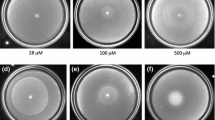Abstract
Swimming bacteria reveal a simple mode of behaviour: their flagella rotate clockwise or counterclockwise by turns and they respond to external stimuli by changing the duration of reversal intervals, thereby migrating in gradients towards attractants or away from repellents in a ‘biased three-dimensional random walk’. The molecular mechanism that regulates the directional change of flagellar rotation is unknown. The light-controlled behaviour of the archaebacterium Halobacterium halobium bears many similarities to chemotaxis in eubacteria1, and offers the advantage of studying the events with a better resolution in time. We have now found in H. halobium that the distribution of the interval length between reversals is log normal and not exponential, as it is in Escherichia coli. During the interval, the rsponsiveness of the cells to attractant stimuli changes in a sawtooth-shaped manner. These results indicate that the intervals between reversals in this organism are regulated by an oscillator which is influenced in opposite directions by attractant and repellent stimuli.
Similar content being viewed by others
References
Hildebrand, E. & Schimz, A. Photochem. Photobiol. 38, 583–597 (1983).
Alam, M. & Oesterhelt, D. J. molec. Biol. 176, 459–475 (1984).
Dencher, N. A. & Hildebrand, E. Z. Naturforsch. 34 c, 841–847 (1979).
Sperling, W. & Schimz, A. Biophys. struct. Mech. 6, 165–169 (1980).
Spudich, J. L. & Bogomolni, A. Nature 312, 509–513 (1984).
Hildebrand, E. & Dencher, N. Nature 257, 46–68 (1975).
Spudich, J. L. & Stoeckenius, W. Photobiochem. Photobiophys. 1, 43–53 (1979).
Hildebrand, E. & Schimz, A. Photochem. Photobiol. 37, 581–584 (1983).
Berg, H. C. & Brown, D. A. Nature 239, 500–504 (1972).
Block, S. M., Segall, J. E. & Berg, H. C. J. Bact. 154, 312–322 (1983).
Hildebrand, E. in Receptors and Recognition, Ser. B, Vol. 5 (ed. Hazelbauer, G.) 37–73 (Chapman & Hall, London, 1978).
Koshland, D. E. Jr Bacterial Chemotaxis as a Model Behavioral System (Raven, New York, 1980).
Author information
Authors and Affiliations
Rights and permissions
About this article
Cite this article
Schimz, A., Hildebrand, E. Response regulation and sensory control in Halobacterium halobium based on an oscillator. Nature 317, 641–643 (1985). https://doi.org/10.1038/317641a0
Received:
Accepted:
Issue Date:
DOI: https://doi.org/10.1038/317641a0
- Springer Nature Limited
This article is cited by
-
Motor responses of Halobacterium halobrium to sinusodial light stimuli
Bioscience Reports (1989)
-
Computer-assisted image analysis in biological sciences
Proceedings / Indian Academy of Sciences (1988)





